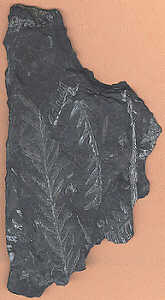
Fossil Fern in Coal In 570 BC, Xenophanes was born. He was one of the first people to write about his observations of fossils. He thought that fossils were an indication that there was water/mud previously in an area.
Dates are given only so you can see the chronology. You will not be required to memorize specific dates, but you will be expected to have some idea of the chronology involved because what is important here is the context in which discoveries and/or speculations were made. What people see and how they interpret it is colored by their point of view. This has also led to and fueled much controversy in certain areas of science.
Thus, the goal here is to understand the “evolution” of our scientific (scientia = to know) thought and knowledge: to be aware of the social, psychological, etc. factors influencing scientific interpretation of the data or how we think about things. Because our current knowledge of biology is so broad, we cannot cover the history of it all, but rather, need to focus on one area to illustrate how our thought processes change. For a topic, then, we’ll use “Where did we come from?” Keep in mind that, in our present-day society, we have created a dichotomy between “science” which is supposed to be totally objective and seeks to discover how something testable happened via the scientific method and experimentation versus “religion” which usually is more subjective and seeks to explain why something happened. Both are needed together to more fully understand the universe around us.
“Aren’t you a star any longer?” asked Lucy.
“I am a star at rest, my daughter,” replied Ramandu. . . .
“In our world,” said Eustace, “a star is a huge ball of flaming gas.”
“Even in your world, my son, that is not what a star is but only what it is
made of. . . .”
— C. S. Lewis, The Voyage of the Dawn
Treader
The dazzlingly obvious conclusion now arose in my mind:
in the whole history of the universe the laws of Nature have never
produced a single event. They are the pattern to which every event must
conform, provided only that it can be induced to
happen. But how do you get it to do that? How do you get a move on? The
laws of Nature can give you no help there.
All events obey them, . . . The laws are the pattern to which events
conform: the source of events must be sought elsewhere.
This may be put in the form that the laws of Nature explain everything except
the source of events. But this is rather a
formidable exception. The laws, in one sense, cover the whole of reality
except — well, except that continuous cataract of
real events which makes up the actual universe. They explain everything
except what we should ordinarily call ‘everything’.
The only thing they omit is — the whole universe. . . .
The smallest event, then, if we face the fact that it occurs (instead of
concentrating on the pattern into which, if it can be
persuaded to occur, it must fit), leads us back to a mystery which lies
outside natural science.
— C. S. Lewis, The Laws of Nature
What is the earliest civilization of which you can think? Of what other early civilizations have you heard? What do you think they knew about biology? Do you think they studied biology as a separate science as we do? While much was also discovered by the ancient Chinese, Native American, and other civilizations, who in many respects are much more in tune with the world around them than “us,” for now, we will limit discussion to the thought processes and discoveries that led to the understanding developed by “western” culture.
Human knowledge of biology began with prehistoric people and their experiences with edible vs. inedible, or even poisonous, plants, habits of animals and how best to capture them, etc. This information was verbally passed on to the next generation. People knew about medicinal and poisonous plants and knew that a heartbeat meant that someone or some animal was alive. They knew that babies were in some way connected with sexual intercourse.
Early on, much basic knowledge had been accumulated by the Egyptians and Babylonians. They also began writing down this knowledge to preserve it and communicate it to those who followed after. By as early as 8500 BC, there is evidence that in Mesopotamia humans raised domesticated goats, sheep, and cereal grains. The Babylonians were quite knowledgeable in a number of areas of science: their knowledge of astronomy was very advanced by even 1500 BC or earlier.
Early peoples did not compartmentalize their lives and knowledge like we do. They saw themselves as part of the whole world around them and everything as integrated and working in harmony. For them, then, their religious beliefs and their scientific thought/knowledge were all the same, and not two separate things like they are for most of us. The Mesopotamian and Egyptian religions looked at the world around them as a very personal “You” with whom they could interact in the same sorts of ways that they could interaction with other people. Thus, the world around them was both their gods and made through the actions of their gods. Because of this, it was not OK to question things – to ask how/why. Things were the way they were because that was the personality and traits of that god, someone who could be offended by a prying human and who might retaliate against this sort of invasion of privacy or questioning of authority. The primeval Chaos was a god who created people and nature and the other gods. These people were just as capable as us of thinking logically and drawing conclusions but often did not do so because it didn’t fit with their experience of reality. In contrast, we see the world around us as a very impersonal “it” with which it unthinkable to have any sort of personal relationship. Because modern science distinguishes between subjective and objective and teaches us that objective is “good” and subjective is “bad,” this creates for us an increasingly wide gulf between our perceptions of phenomena and the concepts by which we explain them. For example, we see the Sun rise and set just as people have done for thousands of years, but we think of this in terms of the Earth’s rotation.
The Hebrew people lived in between the Babylonians (Mesopotamians) and the Egyptains, and based much of their thoughts and knowledge on the influence of their neighbors to either side. Hebrew thought on the origins of the universe and their relationship to the world around them was, however, quite different. Like other civilizations, their early history was passed on orally. Things were first written down about 1500 BC, after they left Egypt. The radical difference between Hebrew thought and that of just about all other civilizations of that time was that their God transcended nature, and was not a part of it. Their God was “You” with whom a personal relationship was possible, but nature was merely “it,” brought into existence by their God. This was a very unusual way of looking at nature as compared to all/most of the other civilizations around them. This viewpoint allowed for the possibility of asking how/why questions about things. In many respects, their creation story is similar to those of their neighbors, especially the Babylonians, but their God pre-existed before and was separate from the primeval chaos, and he created both nature and people.
In the ancient Hebrew creation account as recorded in the book of Genesis (genesis = origin, birth), the Earth was given the ability to produce plants and animals. In Genesis 1: 11, the Creator says, “Let the land produce vegetation.” Verse 12 says, “The land produced vegetation.” Genesis 1:24 adds, “Let the land produce living creatures.” Notice that what’s being created here is not the plants and animals, themselves, but the process whereby they will arise, the Laws of Nature, the “rules of the game” by which the Earth will produce the plants and animals. These verses stand in sharp contrast to earlier verses which say, “Let there be (יְהִ֣י).” In Genesis 1:28, humans are given the responsibility of taking good care of the creation. For those of you who may find this of interest, the Hebrew text of verses 11, 12, 20, and 24 follows, with each word on a separate line.
| 11 | |
| וַיֹּ֣אמֶר | veh = and + amar = to say |
| אֱלֹהִ֗ים | Elohim |
| תַּֽדְשֵׁ֤א | dasha = to bring forth, to cause to yield tender grass |
| הָאָ֙רֶץ֙ | hay = the + erets = earth, land |
| דֶּ֔שֶׁא | deshe = grass |
| עֵ֚שֶׂב | eseb = herb |
| מַזְרִ֣יעַ | meh = from + zara = to sow |
| זֶ֔רַע | zera = seed |
| עֵ֣ץ | ets = tree |
| פְּרִ֞י | peri = fruit |
| עֹ֤שֶׂה | asah = to make, do |
| פְּרִי֙ | peri = fruit |
| לְמִינֹ֔ו | leh = to, by, for, of, according to + min = kind, species |
| אֲשֶׁ֥ר | asher = whose, whosoever |
| זַרְעֹו־בֹ֖ו | zeri = having seed + bo = in him, in it, therein |
| עַל־הָאָ֑רֶץ | al = on, upon, above + hay = the + erats = earth, land |
| וַֽיְהִי־כֵֽן׃ | veh = and + yehi = let there be + khen = so |
| 12 | |
| וַתֹּוצֵ֨א | veh = and + yatsa = to bring forth, to cause to go out |
| הָאָ֜רֶץ | hay = the + erats = earth, land |
| דֶּ֠שֶׁא | deshe = grass |
| עֵ֣שֶׂב | eseb = herb |
| מַזְרִ֤יעַ | meh = from + zara = to sow |
| זֶ֙רַע֙ | zera = seed |
| לְמִינֵ֔הוּ | leh = to, by, for, of, according to + min = kind, species |
| וְעֵ֧ץ | veh = and + ets = tree |
| עֹֽשֶׂה־פְּרִ֛י | asah = to make, do + peri = fruit |
| אֲשֶׁ֥ר | asher = whose, whosoever |
| זַרְעֹו־בֹ֖ו | zeri = having seed + bo = in him, in it, therein |
| לְמִינֵ֑הוּ | leh = to, by, for, of, according to + min = kind, species |
| וַיַּ֥רְא | veh = and + raah = to see |
| אֱלֹהִ֖ים | Elohim |
| כִּי־טֹֽוב׃ | ki = for, that, forasmuch as, certainly, surely, truely + tov = good |
| 20 | |
| וַיֹּ֣אמֶר | veh = and + amar = to say |
| אֱלֹהִ֔ים | Elohim |
| יִשְׁרְצ֣וּ | sharats = to bring forth abundantly, to swarm, to teem |
| הַמַּ֔יִם | hay = the + mayim = waters |
| שֶׁ֖רֶץ | sherets = creeping creature, creeping thing, insect, reptile |
| נֶ֣פֶשׁ | nephesh = life, living soul, living breath |
| חַיָּ֑ה | chaiyah> = living being, beast, living creature |
| וְעֹוף֙ | veh = and + oph = bird |
| יְעֹופֵ֣ף | uph = to fly |
| עַל־הָאָ֔רֶץ | al = on, upon, above + hay = the + erets = earth, land |
| עַל־פְּנֵ֖י | al = on, upon, above + panim = face |
| רְקִ֥יעַ | raqia = firmament |
| הַשָּׁמָֽיִם׃ | hay = the + shamayim = heavens |
| 24 | |
| וַיֹּ֣אמֶר | veh = and + amar = to say |
| אֱלֹהִ֗ים | Elohim |
| תֹּוצֵ֨א | yatsa = to bring forth |
| הָאָ֜רֶץ | hay = the + erets = earth |
| נֶ֤פֶשׁ | nephesh = life, living soul, living breath |
| חַיָּה֙ | chaiyah = beast |
| לְמִינָ֔הּ | leh = to, by, for, of, according to + min = kind, species |
| בְּהֵמָ֥ה | behemah = cattle |
| וָרֶ֛מֶשׂ | veh = and + remes = creeping creature, creeping thing, moving thing |
| וְחַֽיְתֹו־אֶ֖רֶץ | veh = and + chaiyah = beast + erets = earth, land |
| לְמִינָ֑הּ | leh = to, by, for, of, according to + min = kind, species |
| וַֽיְהִי־כֵֽן׃ | veh = and + yehi = let there be + khen = so |
Greek thought went one step farther. They thought of air or water as the first cause of all life (both their gods and humans). These were not an air-god or water-god, and the gods (who were also created) did not create nature nor humans. The gods and humans both came from Gaia, mother Earth, who was not one of the gods on Mt. Olympus, but some sort of a predecessor to everything. Because of this, nature was an “it” to be explored and understood, and it was OK to ask how/why. The Greeks evolved critical thinking. They sought explanations of natural phenomena, and this was the foundations of biology, and most other sciences. This was a period of speculative science with emphasis on nature and mankind. The Greek philosophers were “common people” (not part of any religious or governmental order, sect, or bureaucracy) who desired to understand nature. Much of their thought was on the borderland between mythological/subjective and scientific/objective thought. They didn’t test what they said, but just wrote what seemed logical to them. Much of their writings were blindly accepted up until the Renaissance. Remember, the Greeks were not Christians: their ideas were not Christian ideas, and often bore no relation/resemblance to Hebrew thought and philosophy.
About 600 BC, in India, our present decimal-positional method of writing numbers originated. It took a long time for this mathematical system to make its way to the Mediterranean/European area and even longer for this “pagan” idea to be accepted.
Anaximander, a Greek philosopher who lived from 611 to 546 BC, is credited with the first written work on natural science, a classical poem entitled On Nature. In this poem, he presented what may be the first written theory of evolution He said that in the beginning there was a fish-like creature with scales etc. that arose in and lived in the world ocean. As some of these advanced, they moved onto land, shed their scaly coverings, and became the first humans.

Fossil Fern in Coal
In 570 BC,
Xenophanes
was born. He was one of the first people to write about his observations of
fossils.
He thought that fossils were an indication that there was water/mud
previously in an area.
Empedocles lived around 490 to 444 BC Before this time, the Greeks had disputed which one(s) of four possibilities were the “original” elements: some said one, some said another, some said two together. Empedocles said he thought there were four original elements: Earth, Air, Fire, and Water. He thought that everything else came about through their combination and/or separation by the two opposite principles of Love and Strife.
Hippocrates lived from about 400 to 300 BC. One of the things for which he is remembered is his theory that the human body was composed of the four elements (earth, air, fire, water) plus four fluids or humors: sanguis or blood, produced by the heart; choler or yellow bile, produced by the liver; melancholia or black bile, produced by the spleen; and phlegma or phlegm, produced by the brain, which corresponded with these. This scheme, as subsequently further refined by Galen (see below), was accepted up through Medieval times.
Plato lived from 427 to 343 BC Among the many things for which he is remembered is his idea that there were two worlds. He said the world that which we see is just an illusion, evil, an imperfect copy of the real world, transitory, and will decay. The real world which we cannot see because it’s invisible, is good, perfect, eternal, and static or unchanging. In the real world, there is obviously no variation or change, nor need for any, because all the organisms there, the Types, are perfect. The variation we see among organisms here is because they are imperfect copies of the real Types in the real world. This “pagan” idea was borrowed and incorporated into Christian beliefs, and in sharp contrast to the Jewish belief that we are caretakers of the Earth, has been used to justify our wanton trashing of the planet (“Who cares, since it’s evil and temporary, anyway”).
Heraclides of Pontus, a pupil of Plato, lived from 388 to 315 BC. He was one of the first people to say that the apparent daily rotation of the heavenly bodies was not due to their motion, but rather, due to the rotation of the Earth around its own axis. He also said that Venus and Mercury revolve around the Sun, not the Earth. These two discoveries constituted important steps toward the Copernican theory.
Aristotle, one of Plato’s most famous pupils, lived from 343 to 322 BC, and contributed much to what we now consider to be in the realm of biology. His refinements of the systems of animal and plant classification have profoundly influenced the course of biological thought ever since. His classification system included what he called the Scala naturae, the “scale of nature.” He said that all organisms are arranged in a hierarchy from simplest to most complex, like rungs on a ladder with no vacancies, no mobility, and no change possible since all the spots were full. This idea also was borrowed by early Christianity and replaced the Hebrew concept of “Let the Earth bring forth. . .” Our current technical terms “genus” and “species” are Latin translations of Greek words first used by Aristotle. Aristotle thought that pangenes, particles representative of the various organs, pass from those organs to the reproductive elements (whatever they may be) and convey their own nature/characteristics to the homunculus, a preformed, tiny human that just grew in the mother. This belief was held by people up through and including Darwin, and has led to some very interesting folkloric explanations for birthmarks and birth defects. Aristotle speculated whether an embryo just grew/enlarged from the homunculus (preformation) or underwent development from some undifferentiated (no distinct body parts) unit to a differentiated embryo. This speculation led to 2000 years of debate and controversy.
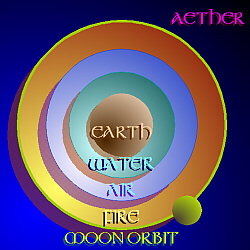
Inner Aristotelian Spheres of the Universe

Lunar Eclipse
In terms of the organization of the universe, Aristotle said that Earth was
both the center of the universe and one of the four primordial elements.
Earth was round, and it was the first sphere followed by spheres of water,
air, and fire in that order, in their proper places. This, he felt, was
obvious from the fact that a thrown clod of earth always fell, as did rain,
while flames of fire constantly ascended to their sphere. The harmonious
relationships and interworkings of these spheres could be heard as celestial
music: the music of the spheres. Above fire was the Moon, and this sphere
delimited matter of a different kind. Beyond the Moon were spheres for the
Sun, the planets, and the stars, which were carried around the Earth in daily,
complicated orbits. All matter inside of the Moon’s orbit was different in
kind from matter above the Moon.

Sailing Around the Curve
Reminiscent of Plato’s ideas, Aristotle’s
theory said that terrestrial matter decays and is ephemeral, while celestial
matter, the
aether,
is unchanging and perpetual. This was yet another “pagan” idea that was
subsequently borrowed by Medieval scholars (see below), both pagan and
Christian, and incorporated into their overall concept of the universe.
Christians incorporated the heavens into their beliefs (see 2 Cor. 12:2-3)
as the place(s) to which people went after death, and this was important
later in the rejection of Copernicus and Kepler as heretics because they
said the Earth was “just another planet” revolving around the Sun. The
implication of a Sun-centered system is that the rest of the universe (the
heavens) is no more perpetual than Earth and will decay too, along with
Earth. This was definitely not a reassuring thought to Medieval Christians
who thought of the heavens as the place “up there in the aether” where all
the Plague victims who were Christians went when they died. As
evidence/support for his view of a round Earth, Aristotle cited examples of
things like how ships disappear over the horizon, mast last, as though
sailing around a curve. Aristotle said that eclipses of the Moon were due
to the shadow of Earth and if the shadow is round, so is the Earth.
In 330 BC, Alexander the Great’s conquests brought much of the known world under Grecian domination, including introduction of Greek language, thoughts, and philosophies in areas where these were previously not known.
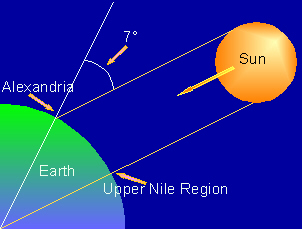
Sun Angles: Alexandria vs. Upper Nile
In the Third Century BC,
Eratosthenes
(who was either Greek or Chaldean) in Alexandria noted that during the
spring or autumn equinox, the noon Sun is directly overhead for residents of
the (south) upper Nile area, but not at Alexandria. There, the Sun was 7°
off from straight up. Since this is about ⅟₅₀
of 360° (the number of degrees in a full circle), he reasoned
that the distance from Alexandria to the upper Nile, which was known, was
also ⅟₅₀ of the circumference of Earth.
His calculations came very close to modern calculations: the diameter which
he calculated in this way is only 50 mi. off from the currently-accepted
value of the “true” diameter (= 7926 mi or 12,756 km) of the Earth. Thus,
not only is Earth round, but we can measure its circumference (it’s still
about 1800 years until Columbus).

In 63 BC, Pompey’s battles and conquests led to Roman rule of most of the “known” world.

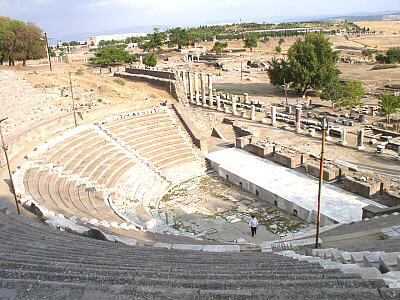
Dr. Fankhauser’s Photo of the Aesclepion Where Galen Taught
Galen
lived from 131 to 210 AD. He was a philosopher, physician, anatomist, and
is famous for his descriptions of human
anatomy
which were considered authoritative for the next 1000 years. He associated
the four humors with Empedocles’ scheme (blood or sanguis, yellow bile or
choler, black bile or melancholia, and phlegma or phlegm. He and subsequent
writers worked out and added to an elaborate system that included the four
organs from which the four humors came, the four seasons, the four stages in
human life, and several other things that came in fours. If someone was ill,
he or she had too much of a particular humor (“he’s in a bad humor today”),
and needed to be treated with an herb with the opposite properties. This
formed the foundation of western medicine up through the Middle Ages, and
beyond. To this day, our culture still contains vestiges of this system,
even though we no longer accept it as true: for example, referring to old
age as the winter of one’s life is still a common poetic analogy. Galen
taught at the Aesclepion in Bergama, Turkey (which, then, was part of Greece)
– Fankhausers went there on vacation in 2003.
Just for comparison on the time scale, the Sixth Century AD is the time of the fading of Rome and in 632 AD the death of Mohammed occurred. In 1000 AD, Leif Ericson was probably the first European to “discover” America, and Islam, which had declined, was again on the upswing and perceived as a “threat” to European Christianity and Judaism. In 1066 AD, the Normans invaded England.
In the Eleventh Century, the Arabs and the spread of Islam were considered a threat to European Christianity, and were fought by the Crusaders. However, the Arabs (formerly Mesopotamia, Babylonia, and Persia, modern Iran and Iraq) were farthest advanced of any other “Western” culture in science, etc., and long before this time, they put together great medical encyclopedias containing the knowledge of both the Arabs and the Greeks. Their translations of Greek works into Arabic saved much of what we know of Greek writings that otherwise would have been lost, and by the 11th Century, many of their documents were available in Latin. They did pioneering work on optics which later led to telescopes and spectacles. Arabic mathematicians furthered their knowledge of the Hindu number system, algebra, and arithmetic. They introduced the use of zero: an unique concept of something to represent nothing.
In the Twelfth to Fourteenth Centuries, in Europe, science, culture, etc. were at a low, hence this time has been referred to as the Dark Ages. Much of the knowledge from the Greeks was lost in European civilization, but preserved among the Arabs. During this time, the Arabic translations of the original Greek were slowly translated into Latin and became available to European scholars. Books were rare, expensive, and hand-written or hand-copied, and while the scholars were quite literate, many “common” people were illiterate. Thus, it was difficult to disseminate knowledge. Medieval scholars held high regard for those previous writings/authors which were available to them (including a variety of Greek, Roman, Arabic, Christian, and Hebrew writings), so much so that if two sources contradicted each other, they were often unwilling to say that one author was “wrong.” Rather, in such cases, they tried to find ways to explain the “apparent” differences and felt that it was important to make one, coherent whole of all known “facts” handed down to them. Thus, they developed, in great detail, Aristotle’s idea of the universe, finding ways to fit in everything they read.
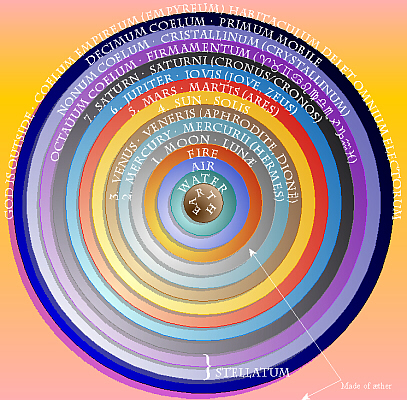
Medieval Concept of the Universe
According to the idea they developed, a round globe or
sphere comprised of earth, the first of the four corruptible “elements” was
at the center of the universe. Since water, obviously, floated on earth,
the next-highest sphere was that of water. Since air, obviously, was above
the water, that was considered to be the next-highest sphere, which reached
almost to the moon’s orbit. Since the flames of a fire continuously leapt
upward, that meant that fire must be the highest of those four spheres.
Combinations of these four elements made up all corruptible (as in, it
can/will decay and/or die and/or change in some way, some day) matter within
the orbit of the moon.
The orbit of the Moon was a significant boundary between the corruptible and the incorruptible. Everything that existed in the higher spheres (or heavens) outside of the orbit of the Moon was composed of an incorruptible (thus, will last as long as the created universe lasts) matter called “aether.” That the Moon waxed and waned was evidence that she was on the boundary with, as it were, one foot in the corruptible and one foot in the incorruptible. The “heavens,” made of aether, included a sphere or “heaven” for each of the seven wandering stars (what we now call planets), including the Moon in the first heaven, Mercury in the second heaven, Venus in the third heaven (actually referred to in the Bible, see 2 Cor. 12: 2-3), the Sun in the fourth heaven, Mars in the fifth heaven, Jupiter in the sixth heaven, Saturn in the seventh heaven, and the fixed stars (including the constellations of the zodiac) in the eighth and ninth heavens called the Firmamentum and the Crystallinum (often grouped together as the Stellatum). The tenth heaven, the Primum Mobile, gave no light, and therefore was not visible, but by its motion, moved all the other spheres/heavens in harmony with it and each other.
God (either the Christian God or the Roman version — Roman religion was, essentially, monotheistic by then) existed in the Empyreum, which was outside of the universe and therefore outside of and not subject to time and space. The eternity of the Empyreum, existing outside of time, was not the same as the perpetuity of the aether. While the aether was incorruptible and would last a long time, until the end of the universe, the timeless Empyreum just was, and was equally “just there” at all times within the universe. Medieval scholars thought that God (Christian or Roman) moved the Primum Mobile in some way not perceptible from within the space and time of the universe, therefore appearing as no motion. The Primum Mobile, in turn, moved all the other spheres/heavens in time with itself. This precisely tuned motion produced harmonious sounds, called the “music of the spheres,” which they said we are unable to hear merely because we constantly hear it, so we don’t notice it. Each of the beings that guided the planets or each of the planets or each of the spheres/heavens had characteristic properties and was associated with a metal, a tree, a weekday (all of the days of the week are named after astrological planets/gods/goddesses), and an occupational/tempermental group of people, who went to that heaven after death. The movements of all those planets were thought to affect the course of events here on earth, and so were carefully studied — astrology was an accepted “fact” in the Christian church, and the big debate was not whether it was true, but rather, whether it totally controlled the course of a person’s life and actions, or whether it merely influenced a person in such a way that a conscientious, alert person could choose to overcome that influence by his/her choices. Calculus, among other types of mathematics, was originally invented by the Chaldeans/Mesopotamians as a means of calculating the positions and movements of the planets, to aid them in astrological predictions. (If you are a person who likes to read the Bible, check out 2 Cor. 12:2. If not, don’t worry about it — it’s nothing you need for this class.)
Living conditions were not always good. People were busy fighting a series of wars from the Crusades to Mongol invasions. Simultaneously, recurrent epidemics of Black Death (Bubonic Plague) swept over Europe. The Plague spread along the trade routes and killed about a third of the population of Europe. Because of the lack of sanitation, large numbers of Black Rats and therefore, rat fleas, were prevalent everywhere. Rat fleas spread Plague from person to person. According to legend, a piper who rid the town of Hamelin, Germany of rats, was not paid for his work, and in retaliation, took all the town’s children away to Transylvania. The Inquisition stifled investigation of nature: people who attempted to discover more about the world around them were often executed as heretics. Accepted/approved ideas in Christian Europe (a mixture/melding of ideas and beliefs from the Judaic background of Christianity and from pagan Greek philosophy) included:
In the Twelfth Century in Toledo, Spain and Palermo, Sicily, groups of Islamic translators made the scientific achievements of the Greeks and Arabs available to the Latin-speaking world. They translated into Latin works on astrology (astro = star), alchemy, magic, also Euclid, Ptolemy, a number of Arabic works, Hippocrates, Archimedes, and Aristotle.
Spectacles were first used in the Thirteenth Century, which was an important step in preparing the way for a later revolution in reading. Gutenberg’s printing press with movable metal type was invented in the Fifteenth Century. Simultaneously, a better understanding of optics and better spectacles were developed. These two discoveries, better books and a better ability to read, helped lead to a wider dissemination of knowledge.
In the Renaissance, there was more openness toward and tolerance of intellectualism and freedom of inquiry. Nicolaus Copernicus, a Polish astronomer, lived from 1473 to 1543. He put forth the theory that the planets all revolve around the Sun, and the turning of the Earth on its axis accounts for the apparent rising and setting of stars.
“In 1492, Columbus sailed the ocean blue.” Interestingly, contrary to what I was taught in elementary school, the “controversy” over funding for his voyage was due not to a disagreement between the “flat Earth-ers” vs. the “round Earth-ers.” Rather, by then, pretty much everyone agreed the Earth was round, but there were two schools of thought on its circumference. One group felt the circumference was too large, such that it would not be possible to stow enough provisions aboard a ship, whereas another group believed the circumference to be sufficiently small, such that it would be possible to provide enough food, etc. for the journey.
In the Sixteenth Century AD, modern math notation came to Europe from the Hindus by way of the Mesopotamians (Arabs). This notation made its way west to Europe via the Arabs several centuries after the Arabs started using it. There were a number of Arabic settlements and Islamic centers of learning in what is now Spain. Typically, knowledge migrated from there up to Paris, and from there to the rest of Europe. In Europe, due to the influence of the Church and the belief that this math notation was a pagan idea, acceptance and use switched only gradually from Roman numerals to the Hindu-Arabic characters. Plus (+) and minus (–) signs were introduced, along with the first use of decimal notation. In Europe, the extension of positional notation to fractions (¾ = 0.75) occurred in the late Sixteenth Century.
Galileo Galilei, an Italian astronomer and physicist, lived from 1564 to 1642. He demonstrated the truth of the Copernican theory with the telescope, and thus, he was condemned for heresy by the Inquisition, and placed under house arrest.
Johannes Kepler, a German astronomer and mathematician, lived from 1571 to 1630. He further refined the ideas of Copernicus. The Sun-centered systems proposed by Copernicus and Kepler were perceived as a threat and vehemently opposed because these ideas robbed the Earth and the Heavens of their uniqueness. If the planets, stars, and Sun were like the Earth, then they were also subject to decay, and the aether was not any more eternal than Earth. This was a threat because people believed that the “heavens,” where people went when they died, were “up there,” and that was suppose to be perpetual or eternal. These ideas were perceived as saying that heaven did not exist and thus were seen as a challenge to the authority of the Church. Imagine for a minute, that you are a Renaissance-era Christian, and have lost many family members to the Plague. How would you react to the idea of a Sun-centered universe?
In about 1600 AD, Francis Bacon founded the empirical or strictly experimental method of scientific inquiry. In his book, Novum Organum (the New Machine), he enunciated the inductive approach which has dominated scientific thinking since then. We will be spending time later discussing this scientific method of problem solving.
Sir Isaac Newton, an English mathematician and philosopher, lived from 1643 to 1727. His laws of gravity were based on not only on the legendary falling apple, but also on the motion of the planets. Apparently he went into hiding to avoid the plague, which gave him the time to think about and develop these theories. The work of Galileo and Newton broke the barrier/distinction between terrestrial and celestial matter (aether) by showing that the same laws of motion that govern the falling of a body (like an apple) on Earth also govern the motion of the planets (including Earth) around the Sun. This was a real threat to the status quo: this meant that the universe was not eternal, therefore not perfect. The heavens are made of the same stuff as the Earth, not aether.
In 1650, Archbishop Ussher calculated a chronology of the Earth based on the genealogies/generations mentioned in available translations of the Old Testament portion of the Bible. Intestingly, many modern Biblical scholars disagree with his interpretation of the phrase “son of” as used in the genealogies and feel that this should be more accurately translated as “heir of,” which brings up the possibility that there could have been several generations in between some of the people listed in the genealogies. Based on his calculations, he dated Adam at 4004 BC, thus he felt that the Earth was about 6000 years old. This gave the Church something to latch on to now that the idea of eternal aether had been challenged, and this dating system was widely-accepted for the next couple hundred years. Here, at least, the Church was still the authority. Note that the idea of a 6000-year-old Earth was not an original part of Judeo-Christian teachings, but is an idea which is only about 350 years old!
The perfect Heaven still existed “up there.” However, “up there” became invisible and mysterious. Still, the perfection (the Types) of this invisible place didn’t allow for change. People still believed in Spontaneous Generation.

Photo of Microscopic View of Cork Bark

Diagram of Microscopic View of Cork Bark
By the late 1600s, observations were being made with the
first, primitive microscopes. These often had highly-polished grains of sand
as lenses. In 1665,
Robert Hooke
was the first person to see and name cells. He examined (dead) cork bark
with a primitive microscope and saw little cubicles which he called
cells (cell = room, cubicle).
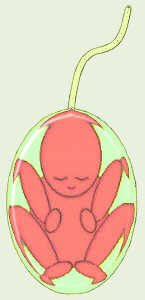
Homunculus in Sperm
Anton van Leeuwenhoek
was the first person to observe sperm cells and with his very primitive
microscope, thought he saw tiny body parts in the sperm. He used this as
“proof” of the idea that the homunculus was in the sperm and the mother’s
body just served as a place for the planted seed to grow. Apparently
Leeuwenhoek, himself, did not claim the sperm was the homunculus, but that
sperm provided major life-giving qualities.
Regnier de Graaf,
on the other hand, thought he saw the homunculus in the egg and that the
sperm merely triggers its growth somehow. This split the preformationists:
was the miniature adult in the egg (followers of de Graaf) or the sperm
(followers of Leeuwenhoek)? Additionally, Leeuwenhoek proposed that
fertilization occurs when the sperm enters the egg, but this could not
actually be observed for another 100 years because of the quality of
microscopes which were available. Most of the subsequent arguments as to the
nature of embryos were based on speculation rather than research.

Francesco Redi’s Fly Experiment
In 1668,
Francesco Redi
did an experiment with flies and open vs. closed flasks which contained meat.
His hypothesis was that rotten meat does not turn into flies. He observed
these flasks to see in which one(s) maggots developed. He found that if a
flask was closed with a lid so adult flies could not get in, no maggots
developed on the rotting meat within. In a flask without a lid, maggots
soon were seen in the meat, followed by more adult flies. The results of
this experiment disproved the idea of spontaneous generation for larger
organisms, but people still thought microscopic organisms like algae or
bacteria could arise that way.
Karl von Linné lived from 1707 to 1778. As was the custom among scholars of that time, he Latinized his name, which became Carolus Linnaeus. He gets credit for our present-day classification scheme and the system of two-part scientific names for organisms, thus has been given the nickname, “The Father of Taxonomy.” He was the first to attempt to classify organisms for their own sake (based on things like similar body structures) rather than to serve some human use. Linnaeus believed that people were supposed to try to discover and decipher the Creator’s scheme, which would become evident as organisms were grouped with “relatives.” He gave two-part Latin names to each organism he knew. For example: Homo sapiens is the scientific name for humans. Note that the genus name (the first name) is always capitalized, but the species name (the second one) never is. Because this is in a foreign language (Latin), when using a computer (or having something done by a printer), it is proper to italicize scientific names. To indicate this when writing or typing a scientific name, you should underline the name. Also, note the spelling of this particular scientific name. The species name, sapiens, is one of those words that ends in “s” (like scissors), and is both singular and plural. Another thing Linnaeus did was an attempt to organize all known organisms into a taxonomic hierarchy which he invented. The levels in this hierarchy, in order are:
Students frequently remember these in order by “kings play chess on fairly green spaces.” In 1753, Linnaeus wrote Species Plantarum, and in 1758, Systema Naturae, 10th Ed.
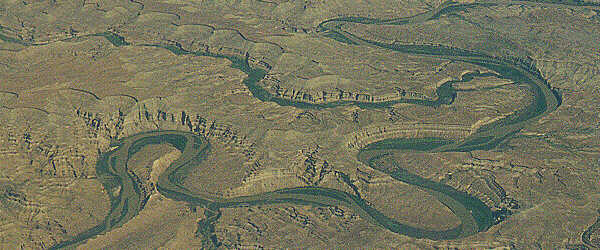
Meandering Gorge of the Green River, E. Utah
James Hutton lived from 1726 to 1797. In 1795, he published a paper, later refined/modified by Charles Lyell (1797-1875), in which he said that land forms can be accounted for by current mechanisms; for example, a gorge was cut by the river running through it, and was not always there. From this, he drew two conclusions:
Needless to say, this sparked much controversy because it was a challenge to all prevalent theories on the age of the Earth (so now Ussher’s wrong, too?), where we came from (a challenge to the Church’s interpretation of the book of Genesis), etc. This was a major challenge to the authority of the Church and the beginnings of our modern-day split between religion and science (objective vs. subjective thought).
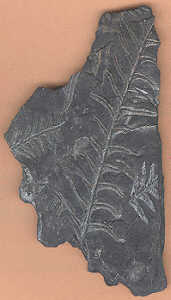
Fossil Fern in Coal
William “Strata” Smith,
an English surveyor lived from 1769 to 1839. He was the first to study the
distribution of
fossils
scientifically. He studied the order of rock
strata
or layers and noted that the same strata in different areas of England
contained the same fossils. He found he could actually use the fossils in
the various strata as indicators of which rock layer he was examining.
In 1798,
Rev. Thomas Malthus,
a sociologist, published a paper in which he looked at conditions in the
poor neighborhoods of London. He said that in humans, the problems of
disease, suffering, starvation etc. were a consequence of the potential for
the human population to grow faster than technology could keep up with.
Things like the supplies of food, medical care, etc. were limited in
comparison to the size of the population, thus there was competition for
available resources and only the strong and healthy would survive. He
was, thus, the first to talk about survival of the fittest.
In either 1802 or 1809, Jean Baptiste Lamarck published his theory of evolution. His main points were:
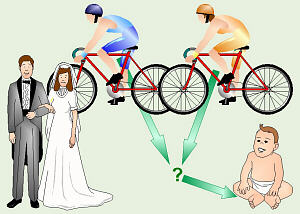
Lamarck’s Theory of Evolution
A number of subsequent attempts were made to support or
disprove this theory without the benefit of our modern knowledge of genetics.
One experiment involved amputation of mouse tails for successive generations,
showing that even after twenty generations, there was no effect: baby mice
were still born with tails. The Jewish practice of circumcision was also
cited as opposing evidence, since obviously it had caused no long-lasting
change in the population and still needed to be done to each new boy baby.
Lamarck’s theory seemed to make sense in the light of the then-accepted
theory of pangenes coming from the body parts to make up the homunculus.
The classic example he used was giraffes. He felt that giraffes’ necks got
longer because they stretched to reach higher leaves, and this was passed on
to their babies. Another example, to make the fallacy of his theory more
apparent, would be two people who developed large arm muscles because they
were blacksmiths, tennis players, or weight-lifters having a baby who was
born with larger than normal arm muscles.
In 1828, Karl von Baer published on the developmental stages in mammalian eggs. He was able to show that an undifferentiated, single-celled egg grows into a many-celled embryo in which the cells all have different functions. This disproved the preformation theory (which said that the preformed homunculus just gets bigger).
In 1859, Charles Darwin published The Origin of Species by Means of Natural Selection or the Preservation of Favoured Races in the Struggle for Life, more commonly known as The Origin of Species. In this landmark book, he made four main points:
Thus in any population, there is descent with modification (changes occur over the generations) due to natural selection (the “pressure” the environment puts on the various genetic varieties in terms of their ability to cope and/or survive). Note that he does not believe in the idea of innate tendency toward greater perfection, nor do organisms willfully “decided” to change, nor does the environment cause any change to occur within an organism. What he does say is that the environment does select various changes that have occurred, in that these (spontaneous) changes make the organism more or less able to cope with various factors in the environment.
There’s an interesting story in all of this that illustrates the sorts of power struggle games that scientists play. In biology, as in many other sciences, there are many people who judge a person’s worth in life by how many publications that person has authored: the name of the game is “Publish or Perish.” After Darwin’s return from his trip around the world on the HMS Beagle, he collected his notes, wrote and thought about his ideas, wrote about them to his friends and colleagues to get their opinions, but did not publish his theory (people have conjectured a number of possible reasons why). Another naturalist, Alfred Russell Wallace, was independently working on a theory that was essentially the same as Darwin’s, and decided to give a presentation on his ideas at an upcoming scientific meeting. Some of Darwin’s friends, including Charles Lyell, arranged things such that at that meeting, they were able to read aloud some of Darwin’s letters to them in which he presented his ideas. They managed to schedule things such that they were able to read these letters just before Wallace’s work was presented. As a result of this, Darwin went down in history as the first person to come up with these ideas, while until recently, Wallace’s work was almost totally ignored. Darwin’s friends subsequently convinced him to publish his theory, and the Origin of Species was the result. Darwin eventually published several other books describing his ideas and theories.
Darwin’s theories spawned a controversy and schism between Christian theologians and scientists that is still evident today. The idea that populations of organisms can and do change genetically over time was in direct contradiction with the Platonic and Aristotelian philosophies that had been grafted into Christianity. If organisms can change (evolve), then the perfect “types” cannot exist. If organisms can change (evolve), then they can’t be neatly arranged in order like rungs on a ladder. If organisms change (evolve), it had to have taken longer than 24 hr for them to have come into existence. If organisms can change (evolve), then humans aren’t any different than “the rest.” If the Earth is round, goes around the Sun like the rest of the planets, our little solar system is just one small part of the universe and is very old, there is no aether, the universe is changing/aging, organisms can change and maybe even turn into other organisms eventually, and just maybe one of those other organisms happens to be humans, then this is a major threat to what many people believed to be true for thousands of years. Predictably, theologians dug in their heels and resisted. Scientists “bent over backwards” to be “totally objective,” and avoid anything that could be perceived as being even a little bit subjective, even to rejecting, en masse, the Judeo-Christian concept of a Creator along with the rejected Greek ideas. One sad consequence of this divorce is that, while amazing scientific discoveries have been made, we often are at a loss for ethical guidelines and the subjective judgements and framework to make the wisest use of those discoveries.
In 1745 to 1748, John Needham, a Scottish clergyman and naturalist showed that microorganisms flourished in various soups that had been exposed to the air. He claimed that there was a “life force” present in the molecules of all inorganic matter, including air and the oxygen in it, that could cause spontaneous generation to occur, thus accounting for the presence of bacteria in his soups. He even briefly boiled some of his soup and poured it into “clean” flasks with cork lids, and microorganisms still grew there.
A few years later (1765 to 1767), Lazzaro Spallanzani, an Italian abbot and biologist, tried several variations on Needham’s soup experiments. First, he boiled soup for one hour, then sealed the glass flasks that contained it by melting the mouths of the flasks shut. Soup in those flasks stayed sterile. He then boiled another batch of soup for only a few minutes before sealing the flasks, and found that microorganisms grew in that soup. In a third batch, soup was boiled for an hour, but the flasks were sealed with real-cork corks (which, thus, were loose-fitting enough to let some air in), and microorganisms grew in that soup. Spallanzani concluded that while one hour of boiling would sterilize the soup, only a few minutes of boiling was not enough to kill any bacteria initially present, and the microorganisms in the flasks of spoiled soup had entered from the air.
This initiated a heated argument between Needham and Spallanzani over sterilization (boiled broth in closed vs. open containers) as a way of refuting spontaneous generation. Needham claimed that Spallanzani’s “over-extensive” boiling used to sterilize the containers had killed the “life force.” He felt that bacteria could not develop (by spontaneous generation) in the sealed containers because the life force could not get in, but in the open container, the broth rotted because it had access to fresh air, hence the life force inherent in its molecules, which contained and replenished the life force needed to trigger spontaneous generation. In the minimally-boiled flasks, he felt the boiling was not severe enough to destroy the life force, so bacteria were still able to develop. By 1860, the debate had become so heated that the Paris Academy of Sciences offered a prize for any experiments that would help resolve this conflict.

Swan-Neck Flask

Silkworm Caterpillars
In 1864,
Louis Pasteur
claimed the prize money and published the results of an experiment he did to
disproved spontaneous generation in these microscopic organisms. He used
flasks of broth, as above, but did not seal any of them. Rather, he used
flasks with S-shaped necks or blocked with cotton to allow fresh air (hence
any “life-force”) to enter, yet keep out any microbes that might be in the
air. Based on his results, Pasteur concluded that there is no such life
force in air, and organisms do not arise by spontaneous generation in this
manner. To quote him,
“Life is a germ, and a germ is Life. Never will the doctrine of
spontaneous generation recover from the mortal blow of this simple experiment.”
Interestingly, Pasteur was probably as much or more interested in science as
a way to make money as he was in making new discoveries. Many of his major
discoveries were paid for by the wine industry or by the silk industry, both
lucrative and important industries in France at that time.
One very important point to note here is that Pasteur did not seek to find an answer to the broad question, “Has spontaneous generation ever occurred?” Rather, as any good scientist, he limited his scope to a very narrow piece of the picture: “Is it possible for spontaneous generation to occur given the specific conditions, i.e. the ‘life force,’ under which Needham (and others) claims it will occur?” Interestingly, when Oparin published The Origins of Life, in which he described hypothetical conditions which he felt would have been necessary for life to first come into existence on early Earth, some scientists found it difficult to acknowledge that under the very different conditions which Oparin was proposing for early Earth, some form of “spontaneous generation” might indeed have taken place.
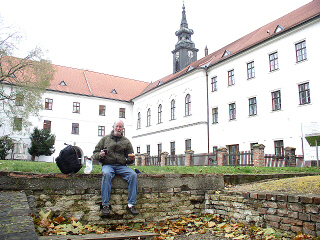
Dr. Fankhauser at Mendel’s Monastery
In 1865,
Gregor Mendel,
an Austrian monk, published a paper on
genetics
that earned him the nickname “the Father of Modern Genetics.” One of Mendel’s
jobs at the monastery was to care for the garden. As he went about his
chores, he noticed that some of his pea plants were tall while others were
short, some had purple flowers while others had white, some had yellow seeds
while others had green, and some had wrinkled seeds while others had smooth
seeds. As Mendel raised peas, he made specific crosses between certain plants
and did something very unusual for biology in those days: he counted the
results. From this he developed a theory of genetics that refuted the
pangene/homunculus idea and enabled people to predict the outcome of a
genetic cross if the genes of the parents were known. When Mendel first
published his paper, the idea of the pangenes was still so deeply held that
people ignored his work or dismissed it as false. It wasn’t until 1900 that
a couple of botanists working on other research rediscovered his work. We
will discuss Mendel’s theory in more depth when we talk about genetics.
In 1870 the process of mitosis, regular cell division by which one cell divides to make two cells, was observed, and researchers noticed that chromosomes, whose function was not understood, were moving around in the cell during mitosis so that each daughter cell got an exact set of them. In 1890 the process of meiosis, a special cell division involved in producing eggs or sperm, was observed. Again, researchers did not yet understand what chromosomes were, but they did note that as a result of meiosis, each egg or sperm cell formed had half as many chromosomes as the original cell. Thus, after Mendel’s work was rediscovered in 1900, researchers started seeing parallels between his theory of genetics and what the chromosomes were doing in mitosis and meiosis. From this, people figured out that Mendel’s genes were on the chromosomes. In the 1940s, people finally started fitting the two together. People began to think that the DNA in the chromosomes was the genetic material, but because its chemical structure was unknown, a lot of biologists were skeptical about this idea.
In 1936, Alexander Ivanovich Oparin, a Russian scientist, published The Origins of Life, in which he described hypothetical conditions which he felt would have been necessary for life to first come into existence on early Earth. This included an atmosphere of methane, ammonia, and other gases, much volcanic activity, lightening, and warm soil and water temperatures. This hypothesis was later tested by an experiment done by Stanley Miller as a grad student under Harold Urey in 1953. We will be discussing these ideas in more depth in Biology Lecture 2.
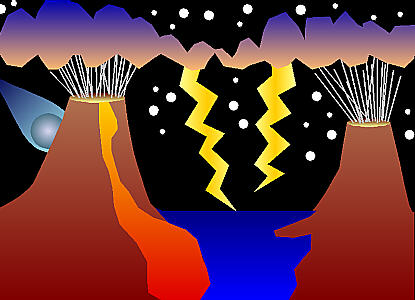
Oparin’s Hypothesis on Origins of Life on Earth
Also in 1953, James Watson, an American, and Francis Crick, an Englishman, published a paper in which they proposed a hypothetical structure for DNA which also showed how DNA could be the genetic code material and suggested a means whereby it could replicate itself. Subsequent chemical analyses of DNA have upheld their prediction.
Since that time, the Modern Synthetic Theory of Evolution was developed based on the theories of Darwin, Mendel, Malthus, Lyell, Oparin, and many others, including more recent work in genetics, geology, paleontology, and animal behavior. This theory, itself continually being revised as new information becomes available, challenges many long-held views on how the Earth and living organisms came to be. It says that the Earth is very old, and living organisms came from others by a process of slow change. One interesting modern development, spawned by the continued lack of the “missing links” despite our best efforts to find them, is the argument over gradualism (slow, constant, gradual change in organisms) vs. punctated equilibrium (“abrupt” change over a few thousand years followed by long periods during which, little change takes place).
One parting thought — what’s your opinion?
Up until about 100-150 years ago, science/biology and “religion” were
intertwined in human thought and culture. The religious aspect, although
sometimes abused, gave people a sense of right and wrong, morals, and/or
ethics. Since Darwin’s time, in Western culture, science and religion have
pretty much gone their own ways at a time when new discoveries are constantly
being made in science. Since then, science has “bent over backwards,” as it
were, to insure objectivity and make sure it has nothing to do with religion,
which many scientists reject as being too subjective. In the last 40 years
since the publication of Watson and Crick’s paper on DNA, our biological
knowledge has increased exponentially, especially in the field of genetics,
and now we’re realizing there’s no ethical framework on which to hang it.
There are all sorts of fantastic, and perhaps lifesaving, things that we are
capable of doing which also give us the ability to annihilate whole segments
of the human population and/or whole other species of organisms. People have
claimed that our knowledge had grown faster than our ability to make the
ethical decisions, but sometimes I wonder if maybe we’ve ignored/stifled
ethics in the name of “objectivity.”
Alcamo, I. Edward. 1997. Fundamentals of Microbiology, 5th Ed. Benjamin Cummings Publ. Co., Menlo Park, CA. (pp. 7-9)
Bobrick, Benson. 2005. The Fated Sky. Simon & Schuster. New York, NY.
Borror, Donald J. 1960. Dictionary of Root Words and Combining Forms. Mayfield Publ. Co.
Campbell, Neil A., Lawrence G. Mitchell, Jane B. Reece. 1999. Biology, 5th Ed. Benjamin/Cummings Publ. Co., Inc. Menlo Park, CA. (plus earlier editions)
Campbell, Neil A., Lawrence G. Mitchell, Jane B. Reece. 1999. Biology: Concepts and Connections, 3rd Ed. Benjamin/Cummings Publ. Co., Inc. Menlo Park, CA. (plus earlier editions)
Cosman, Madeleine P. 1976. Fabulous Feasts: Medieval Cookery and Ceremony. Geo. Braziller, Inc., NY.
Curtis, Helena. 1983. Biology, 4th Ed. Worth Publ. New York, NY.
Frankfort, Henri, et al. 1971. Before Philosophy: The Intellectual Adventure of Ancient Man. Penguin Books. Baltimore, MD (© Univ. of Chicago Press).
Heath, Thomas L. 1991. Greek Astronomy. Dover Publ., Inc. New York, NY.
Heidel, Alexander. 1969. The Babylonian Genesis, 2nd Ed. Phoenix Books, Univ. of Chicago Press, Chicago, IL.
Lewis, C. S. 1952, 1980. The Voyage of the Dawn Treader. HarperTrophy Div. of HarperCollins Publ. New York, NY.
Lewis, C. S. 1964, 2007. The Discarded Image. Cambridge University Press. New York, NY.
Lewis, C. S. 1966, 2007. Studies in Medieval and Renaissance Literature. Cambridge University Press. New York, NY.
Lewis, C. S. 1970. The Laws of Nature. God in the Dock. Walter Hooper, Ed. Wm. B. Eerdmans Publ. Co. Grand Rapids, MI.
Lewis, Ricki. 1992. Life. Wm. C. Brown. Dubuque, IA.
Marchuk, William N. 1992. A Life Science Lexicon. Wm. C. Brown Publishers, Dubuque, IA.
Parker, Andrew. 2009. The Genesis Enigma: Why the Bible Is Scientifically Accurate. Dutton-Penguin Group. NY.
Sant, Joe. 2002. pers. comm.
Schroeder, Gerald L. 1990. Genesis and the Big Bang. Bantam Books. NY.
Sobel, Dava. 2000. Galileo’s Daughter. Penguin Books. New York, NY.
Ward, Michael. 2008. Planet Narnia. Cambridge University Press. New York, NY.
(plus a variety of other introductory biology textbooks)
Genesis 1 in Hebrew from http://www.biblegateway.com